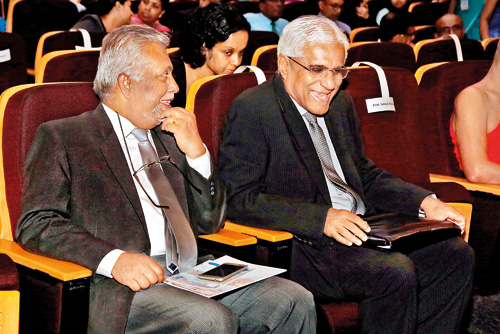Trust promotes trade and trade promotes trust, says CB Governor
A cross country analysis shows that when there is trust among people, economies do well. Trust promotes trade and trade promotes trust and these two characters are mutually enforcing, says Governor of the Central Bank of Sri Lanka, Dr. Indrajit Coomaraswamy.

Prof. Lakshman Dissanayake, Vice Chancellor of the University of Colombo, in conversation with Central Bank Governor Dr. Indrajit Coomaraswamy at the event. Pic by Priyantha Wickremaarachchi
Delivering his keynote address at the inauguration of the 15th South Asian Economics Students Meet held at the University of Colombo on Monday, Dr. Coomaraswamy said that trade also promotes inter-dependence and constituencies for peace.
Lack of trust has greatly inhibited trade and development in the South Asian (SA) region, he added elaborating that SA countries trade on better terms with non-regional partners than with their neighbours.
The trade restrictiveness index shows that for India, Nepal, Pakistan and Sri Lanka it is two to nine times higher for imports from the SA region than for imports from the rest of the world. The cost of trade is also disproportionately high in SA compared with other regions. Average cost is 20 per cent higher than ASEAN region.
“On the downside side, the region also faces some daunting challenges in terms of poverty, unemployment and electricity. Access to healthcare is very low. The region has 40 per cent of the worlds’ poor. By adopting the right mix of internal and cross border economic policy reforms, promoting regional connectivity and adopting a range of other measures SA can make a measurable dent in poverty and promote development in the region,” stressed Dr. Coomaraswamy.
He stated that all SA countries can benefit from increased regional integration. SA is the least integrated region in the world. Inter-regional trade accounts for only five per cent of total trade. The corresponding figure for East-Asia and Pacific regions is 50 per cent and for South Sahara and Africa its 22 per cent. As a percentage of regional GDP, inter-regional trade amounts to about one per cent in SA as opposed to 2.6 per cent in South Sahara and Africa and 11 per cent in East-Asia and Pacific regions. As barriers are high, a significant volume of trade flows through informal routes in the region involving either a third country or through avoiding customs barriers. Informal trade has been estimated at about 50 per cent of formal trade. Even when this is taken into account SA is still the least integrated region in the world. Inter-regional trade investments are also extremely disappointing. Regional supply chains are very limited outside the textiles and garment sector.
Dr. Coomaraswamy noted that SA must establish a schedule for the elimination of para-tariffs within a time frame that is credible, taking into account the impact of government revenue and domestic producers. The exercise can begin by accelerating removal of para-tariffs on items and not on sensitiveness. There must be a multi prompt approach progress on non-tariff barriers, information clause, trade facilitation methods, infrastructure development and the related issue of connectivity costs.
Ways and means of promoting people to people contact in the region must be pursued rigorously, he stressed. There should be clearly articulated national trade policy strategies giving high priority to regional integration, holistic approach that covers calibrated trade liberalisation, trade facilitation, improvement in the ease of doing business, attracting FDIs, improving links between education, training and skills development and labour market, strengthening safety and training for workers and a transparent fiscal package for firms that will be an aggressive affect by trade reforms.
SA has had a challenging and troubled history but the nation building process in the countries have persisted for decades. “We need to look at Japan, China and South Korea. Those countries too have had a troubled history but they have been able to transcend and rise above those tensions and to be very pragmatic in terms of their commercial buildings. There are billions of dollars’ worth of trade that is taking place in the East Asian region. SA has been far more emotional that has not allowed it to get in the way of commercial opportunity. We need to look at other regions and learn,” he noted.


